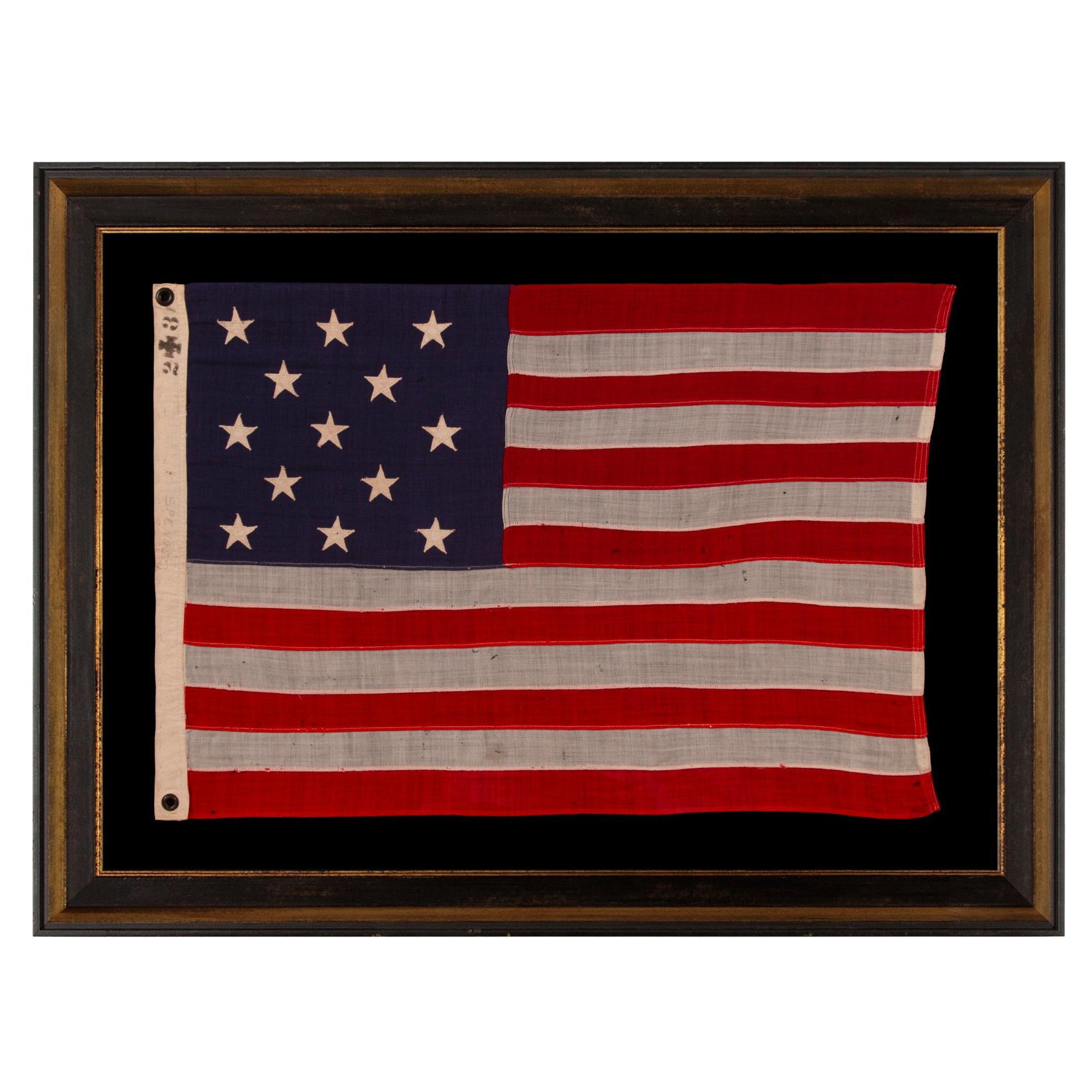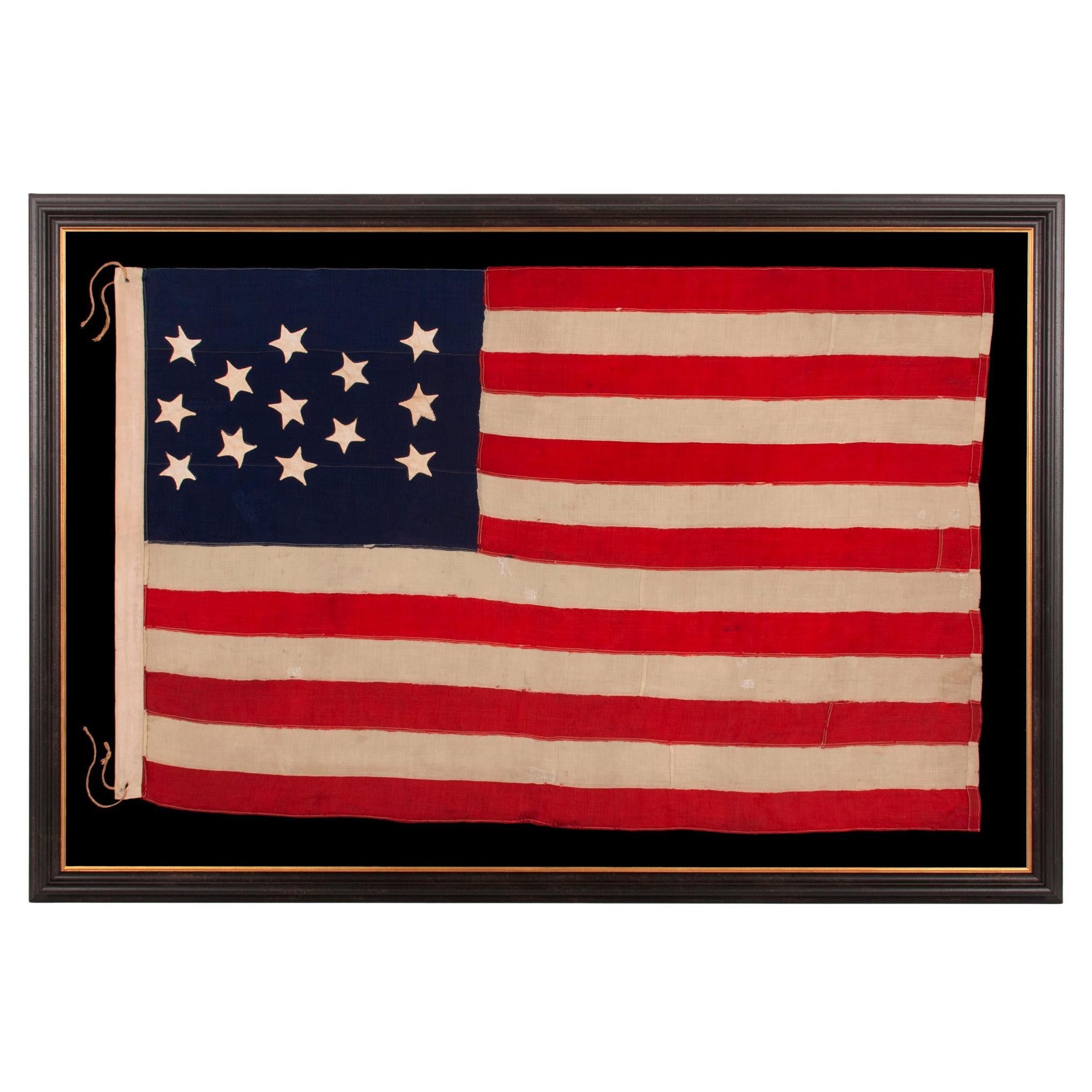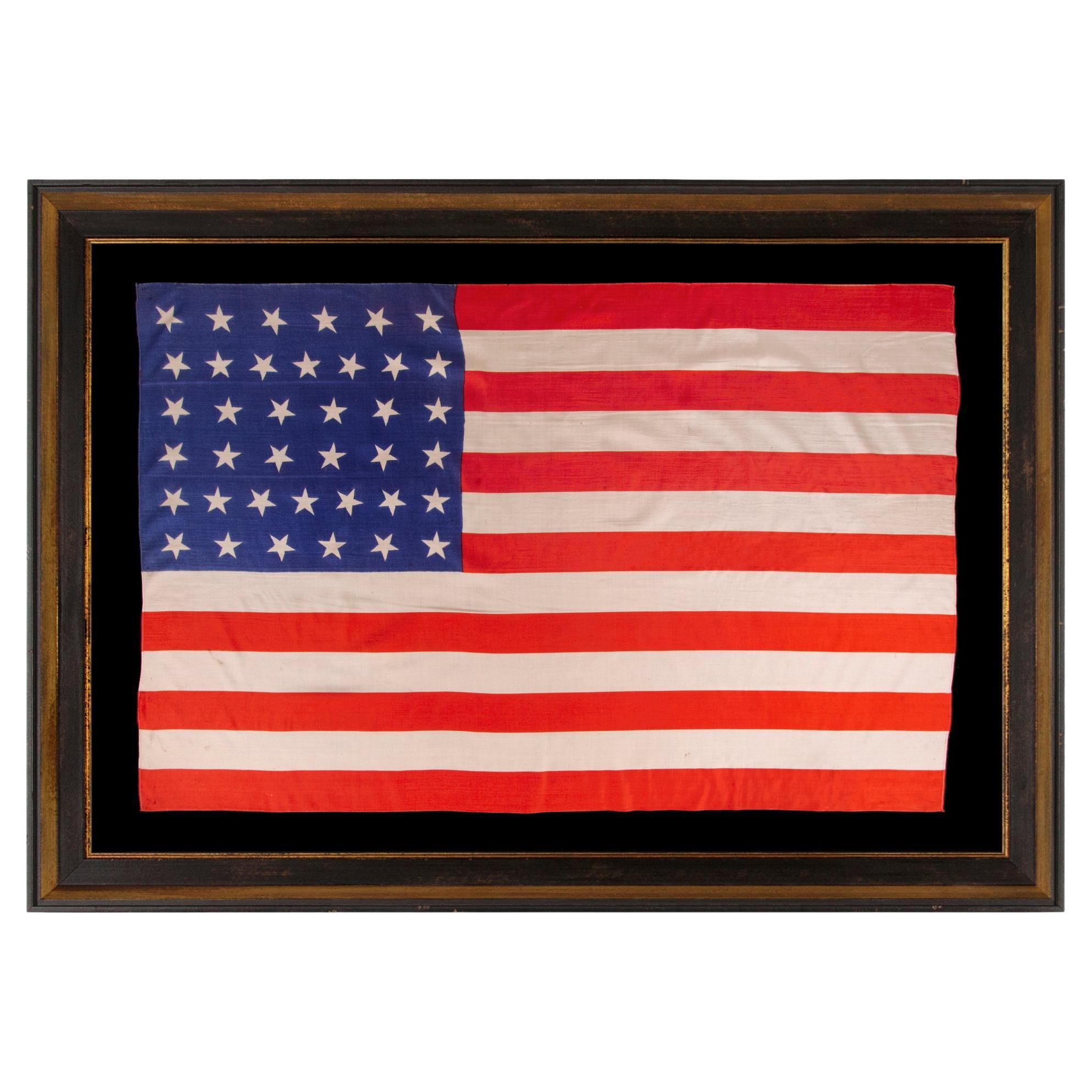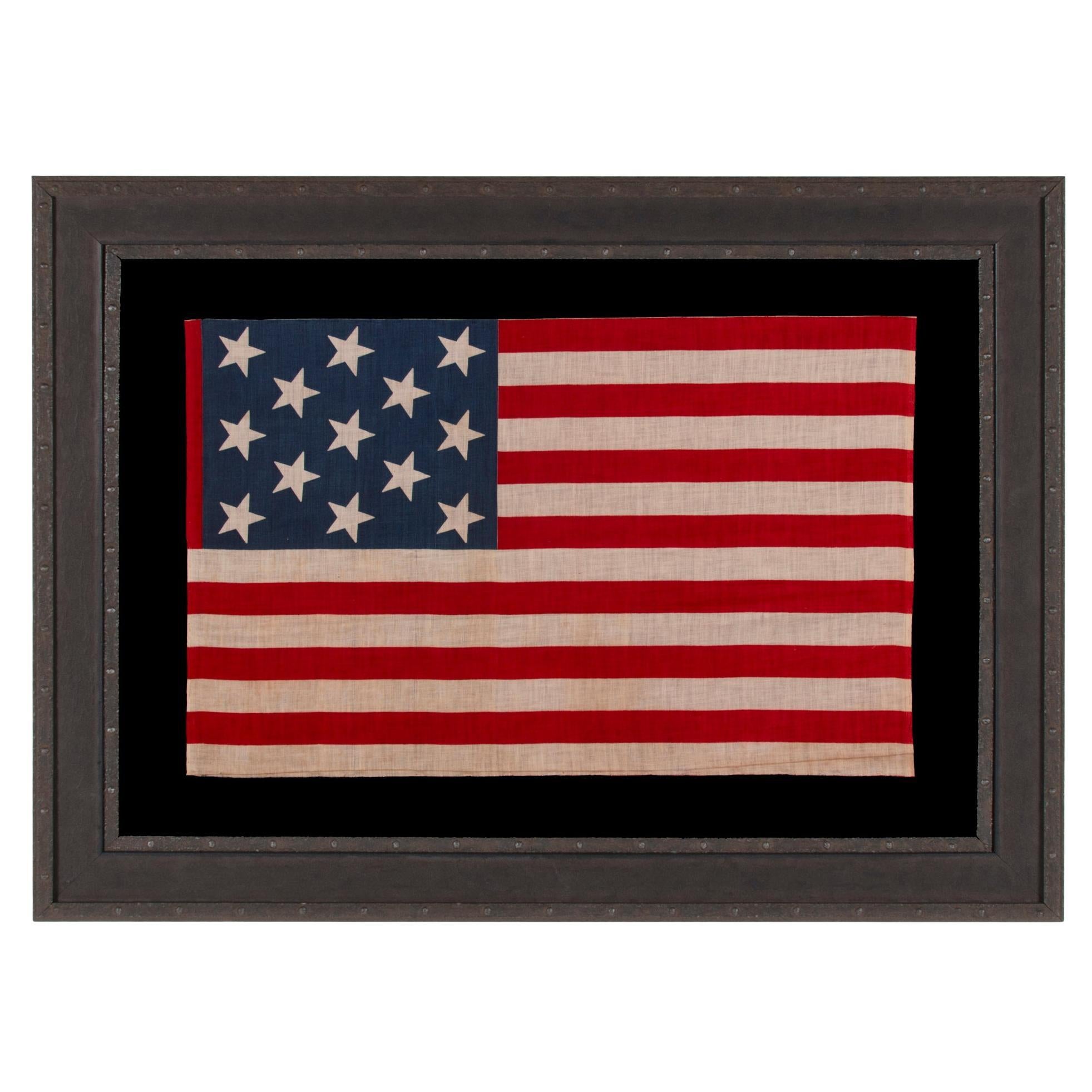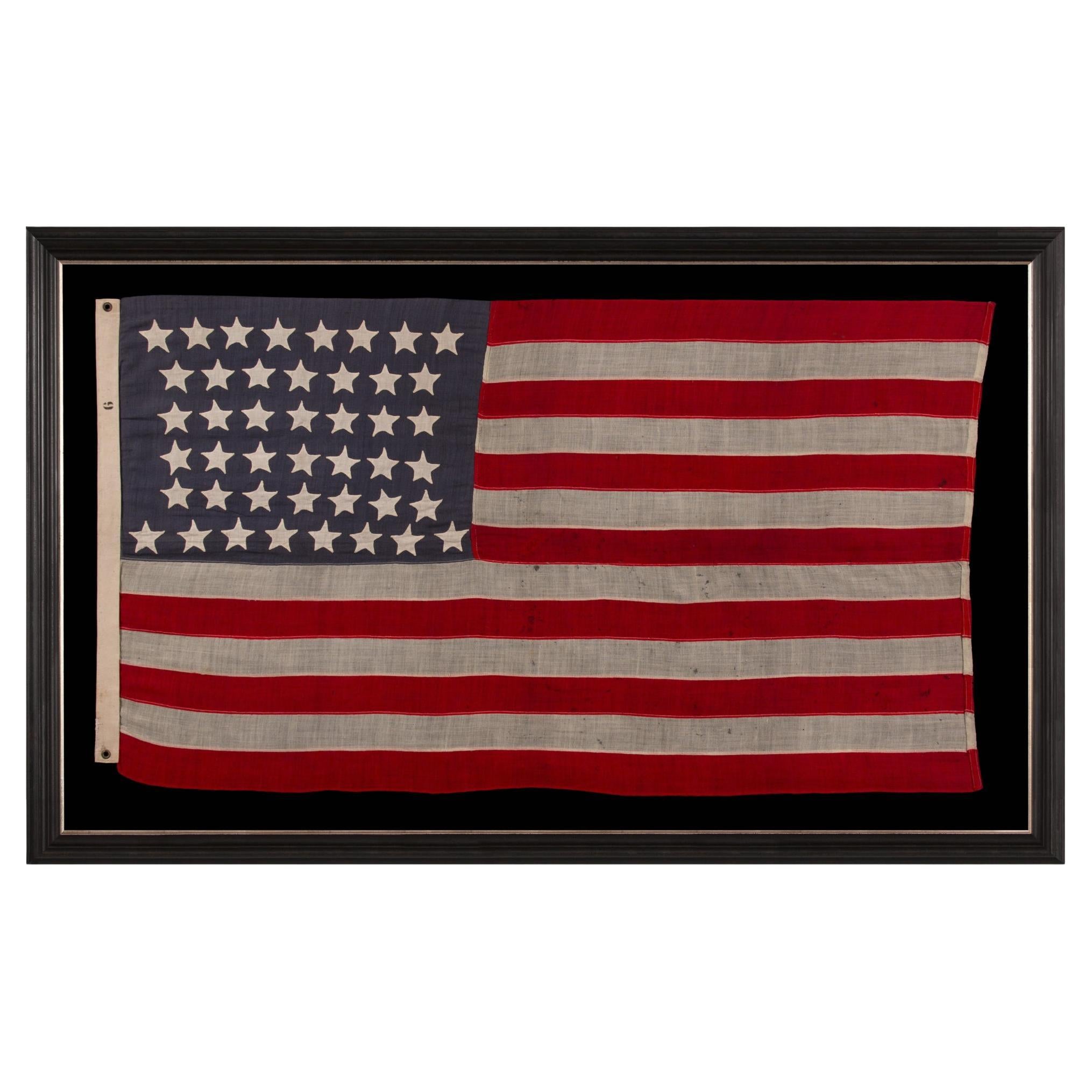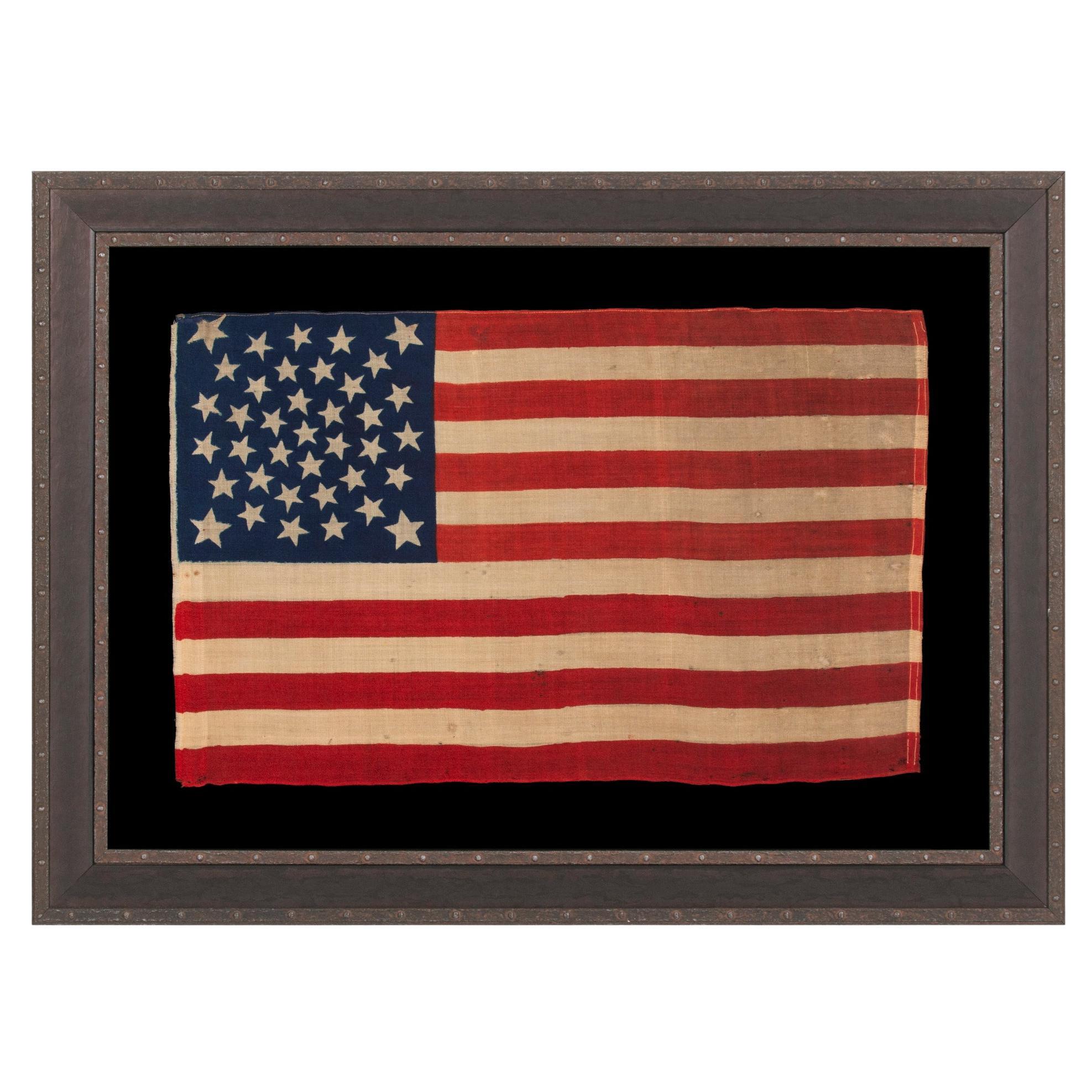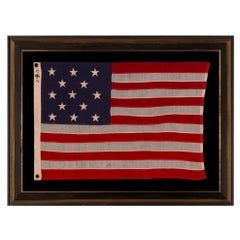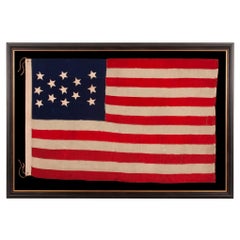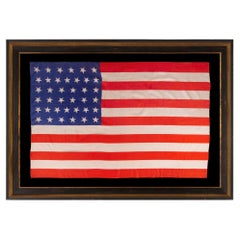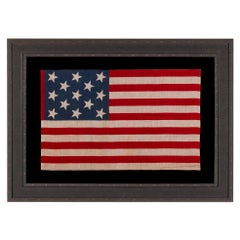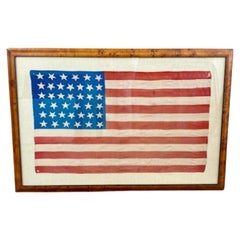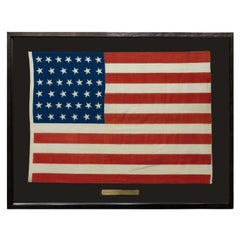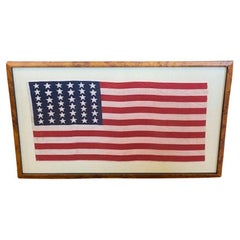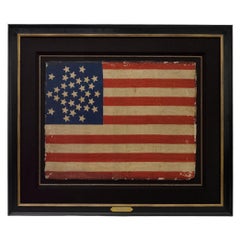Items Similar to 13 Star Antique American Flag, Marked "R.H Macy & Co", circa 1895-1926
Want more images or videos?
Request additional images or videos from the seller
1 of 7
13 Star Antique American Flag, Marked "R.H Macy & Co", circa 1895-1926
Price Upon Request
Price Upon Request
Price Upon Request
Price Upon Request
Price Upon Request
Price Upon Request
Price Upon Request
Price Upon Request
Price Upon Request
Price Upon Request
Shipping
Retrieving quote...The 1stDibs Promise:
Authenticity Guarantee,
Money-Back Guarantee,
24-Hour Cancellation
About the Item
13 STAR ANTIQUE AMERICAN FLAG WITH A 3-2-3-2-3 CONFIGURATION OF STARS; A SMALL-SCALE EXAMPLE, MADE IN THE 1895-1926 ERA, MARKED “R.H. MACY & CO.”
13 star antique American flag of the small-scale type made during the last decade of the 19th century through the beginning of the 20th. The canton and stripes are made of wool bunting that has been pieced with lineal, machine stitching. The stars are made of cotton and are double-appliquéd (applied to both sides) with a zigzag machine stitch. These are arranged in staggered rows of 3-2-3-2-3. There is a narrow, twill cotton binding along the hoist, folded over at the top and bottom for added strength, prior to installation, with two white metal grommets.
Because there was no official star design for the American flag until 1912, the star pattern was left to the whims of the maker. The 3-2-3-2-3 design became the most often seen 13 star configuration during the latter 19th century and remained so throughout the first quarter of the 20th. In most cases this can also be viewed as a diamond of stars, with a star in each corner and a star in the very center. It is likewise of interest to note that it can also be interpreted as a combination of the crosses of St. Andrew and St. George, which may reflect a link between this arrangement and the British Union Jack.
The 3-2-3-2-3 pattern is often attributed--erroneously in my opinion--to New Jersey Senator Francis Hopkinson, a member of the Second Continental Congress and of the Marine Committee, and signer of the Declaration of Independence, who is generally credited with having played the most significant role in the design of the American national flag prior to its June 14th, 1777 adoption. As an amateur artist and an enthusiast in heraldry, Hopkinson designed various official colonial American devices, including the Great Seal of the Treasury and various pieces of colonial currency. He also submitted designs for the Great Seal of the United States. Although Hopkinson’s original sketches for the American flag do not survive, his depictions of 13 star arrangements on other devices do not reflect the 3-2-3-2-3 configuration falsely attributed to him. This seems to have developed from someone’s unsuccessful attempt to make sense of the designs he presented on both drafts submitted to Congress for the Great Seal, which were decidedly random and most certainly intentional in this regard.
The canton and stripes of the flag are made of wool bunting that has been pieced with machine stitching. The stars are made of cotton and double-appliquéd (applied to both sides of the flag) with a zigzag machine stitch. There is a twill cotton binding along the hoist, with two brass grommets, along which “2X3” appears in a faded, red-inked stencil, and the same is hand-inscribed in pencil, to indicate size in feet.
The name “R.H. MACY & CO.” is boldly stenciled in black, near the top of the hoist, likely to indicate ownership. This flag would likely have been displayed by Macy’s department store as decoration, possibly for the opening of its Herald Square location in 1902, or in the patriotism of WWI (U.S. involvement 1917-18), or perhaps to celebrate the 150th anniversary of American independence in 1926. Although Macy’s is likely to have also sold flags, the fact that I have seen just two others with this mark may suggest more limited use.
Why 13 Stars? As the number of stars grew with the addition of new states, it became more and more difficult to fit their full complement on a small flag. The stars would, by necessity, have to become smaller, which made it more and more difficult to view them from a distance as individual objects. The fear was that too many stars would become one white mass and distort the ability to identify American ships on the open seas.
The U.S. Navy used 13 stars on its small-scale flags for precisely this reason. This was, of course, the original number of stars on the first American national flag, by way of the First Flag Act of 1777, and equal to the number of original colonies that became states.
For all practical purposes, commercial flag-makers simply didn't produce flags with pieced-and-sewn construction that were 3 to 4 feet in length before the 1890's. There are exceptions to this rule, but until this time, the smallest sewn flags were generally around 6 feet on the fly. Lengths of 8 feet long and larger were common. Their primary use long having been more utilitarian than decorative, to serve well as signals, flags needed to be large to be effective. Pre-1890, even those sewn flags made for general patriotic display were typically way larger than their modern counterparts. While most early use of flags with sewn construction was to mark ships and government buildings, eventually spreading to local militia and to formal U.S. & state military companies, private use grew with the passage of time, raising the need for long-term use flags of a more manageable scale.
Beginning around 1890, commercial flag-makers began to produce small flags for the first time in large quantities, namely with dimensions of 2 x 3 feet, like this example, or 2.5 x 4 feet. Applying the same logic as the U.S. Navy, they chose the 13 star count rather than the full complement of stars for sake of ease and visibility. Because any flag that has previously been official remains so according to the flag acts of Congress, all 13 star, 13 stripe flags remain official national flags of the United States of America.
The 13 star count has been used throughout our nation's history for a variety of purposes. In addition to being flown by the Navy, 13 star flags were hoisted at patriotic events, including Lafayette’s visit in 1824-25, the celebration of the nation's centennial in 1876, and the sesquicentennial in 1926, as well as for annual celebrations of Independence Day. They were displayed during the Civil War, to reference past struggles for American liberty, and were used by 19th century politicians in political campaigning. The use of yachting ensigns with a wreath of 13 stars surrounding a fouled anchor, which allowed pleasure boats to bypass customs between 1848 and 1980, persists today without an official purpose.
Brief History of R.H. Macy & Co.
“Rowland Hussey Macy opened four retail dry goods stores between 1843 and 1855. One of them was the original Macy's store in downtown Haverhill, Massachusetts; it opened in 1851 to serve the mill industry employees of the area. They all failed, but he learned from his mistakes. Macy moved to New York City in 1858, to establish a new store named "R. H. Macy & Co." on Sixth Avenue between 13th and 14th Streets. The location was far north of where other dry goods stores were at the time…
“As the business grew, Macy's expanded into neighboring buildings, opening more and more departments. The store used publicity devices such as a store Santa Claus, themed exhibits, and illuminated window displays to draw in customers…
In 1875, Macy took on two partners, Robert M. Valentine (1850–1879), a nephew; and Abiel T. La Forge (1842–1878) of Wisconsin, who was the husband of a cousin. Macy died in 1877 from inflammatory kidney disease (then known as Bright's disease).[15] La Forge died the following year, and Valentine died in 1879. Ownership of the company remained in the Macy family until 1895, when the Straus brothers acquired the company. Isidor Straus and his brother Nathan Straus had previously held a license to sell china and other goods in the Macy's store.
In 1902, the flagship store moved uptown to Herald Square at 34th Street and Broadway, so far north of the other main dry goods emporia that it had to offer a steam wagonette to transport customers from 14th Street to 34th Street. Although the Herald Square store initially consisted of just one building, it expanded through new construction, eventually occupying almost the entire block bounded by Seventh Avenue on the west, Broadway on the east, 34th Street on the south and 35th Street on the north… In 1912, Isidor Straus died in the sinking of the Titanic at the age of 67 with his wife, Ida…
The original Broadway store was designed by architects De Lemos & Cordes, was built in 1901–02 by the Fuller Company and has a Palladian facade, but has been updated in many details. There were further additions to the west in 1924 and 1928…designed by architect Robert D. Kohn.” [Source: Wikipedia]
Macy’s Herald Square location was the biggest retail store in the world. It retained this title until 2009, when it was surpassed by Shinsegae Centum City Department Store in Busan, South Korea.
Mounting: For 25 years we have maintained our own textile conservation department, led by a master’s degree level graduate from one of the nation’s top university programs. We take great care in the mounting and preservation of flags and related textiles and have preserved thousands of examples.
The flag has been hand-stitched to 100% silk organza for support throughout. It was then hand-stitched to a background of 100% cotton twill, black in color, that was washed and treated for colorfastness. The black-painted and gilded molding, with its wide, serpentine profile, is Italian. The glazing is U.V. protective acrylic (Plexiglas). Feel free to inquire for more details.
Condition: There is a small hole adjacent to the fly end of the 3rd red stripe, accompanied by tiny holes in the 4th, 5th, and 6th red stripes, and a couple along the lower edge of the last. There is extremely minor soiling along the hoist binding and in the stars. The overall condition is exceptional among wool flags of the period.
- Dimensions:Height: 35 in (88.9 cm)Width: 49 in (124.46 cm)Depth: 2.5 in (6.35 cm)
- Materials and Techniques:
- Place of Origin:
- Period:
- Date of Manufacture:1895-1926
- Condition:See Item Description.
- Seller Location:York County, PA
- Reference Number:Seller: 13j-17171stDibs: LU849743948312
About the Seller
5.0
Recognized Seller
These prestigious sellers are industry leaders and represent the highest echelon for item quality and design.
Established in 1991
1stDibs seller since 2008
70 sales on 1stDibs
Typical response time: 1 to 2 days
- ShippingRetrieving quote...Shipping from: York County, PA
- Return Policy
Authenticity Guarantee
In the unlikely event there’s an issue with an item’s authenticity, contact us within 1 year for a full refund. DetailsMoney-Back Guarantee
If your item is not as described, is damaged in transit, or does not arrive, contact us within 7 days for a full refund. Details24-Hour Cancellation
You have a 24-hour grace period in which to reconsider your purchase, with no questions asked.Vetted Professional Sellers
Our world-class sellers must adhere to strict standards for service and quality, maintaining the integrity of our listings.Price-Match Guarantee
If you find that a seller listed the same item for a lower price elsewhere, we’ll match it.Trusted Global Delivery
Our best-in-class carrier network provides specialized shipping options worldwide, including custom delivery.More From This Seller
View All13 Star Antique American Flag, Inscribed "Spenge" ca 1895-1926
Located in York County, PA
13 STAR ANTIQUE AMERICAN FLAG WITH A 3-2-3-2-3 CONFIGURATION OF STARS ON AN ATTRACTIVE, INDIGO BLUE CANTON; A SMALL-SCALE EXAMPLE OF THE 1895-1926 ERA, INSCRIBED WITH THE SURNAME “SP...
Category
Antique Late 19th Century American Political and Patriotic Memorabilia
Materials
Wool
13 Star Antique American Flag with a Narrow Star Presentation, ca 1876
Located in York County, PA
13 STAR ANTIQUE AMERICAN FLAG WITH HAND-SEWN STARS IN AN EXTREMELY NARROW PRESENTATION OF A 3-2-3-2-3 ARRANGEMENT ON A CANTON THAT DOESN’T FOLLOW SUIT, LEAVING WIDE EXPANSES OF BLUE ...
Category
Antique 1870s American Political and Patriotic Memorabilia
Materials
Wool
Price Upon Request
38 Star Antique American Flag, Colorado Statehood, circa 1876-1889
Located in York County, PA
38 star antique American parade flag with scattered star orientation, made of silk, with generous scale and vivid colors, Colorado Statehood, 1876-1889
38 star American national p...
Category
Antique Late 19th Century American Political and Patriotic Memorabilia
Materials
Silk
Price Upon Request
13 Star Antique American Parade Flag, ca 1876-1899
Located in York County, PA
13 STAR ANTIQUE AMERICAN PARADE FLAG, WITH A 3-2-3-2-3 CONFIGURATION OF STARS, AN EXTREMELY SCARCE AND UNUSUALLY LARGE VARIETY, MADE circa 1876-1899
13 star American national parade...
Category
Antique Late 19th Century Canadian Political and Patriotic Memorabilia
Materials
Cotton
Price Upon Request
44 Star Antique American Flag, Wyoming Statehood, ca 1890-1896
Located in York County, PA
44 STAR ANTIQUE AMERICAN FLAG WITH AN HOURGLASS ARRANGEMENT ON A DUSTY BLUE CANTON; REFLECTS THE ERA WHEN WYOMING WAS THE MOST RECENT STATE TO JOIN THE UNION, 1890-1896
Wyoming was ...
Category
Antique 1890s American Political and Patriotic Memorabilia
Materials
Wool
Price Upon Request
38 Star American Flag, Colorado Statehood, Made by Horstmann Brothers ca 1876
Located in York County, PA
38 STARS, COLORADO STATEHOOD, A SCARCE AND BEAUTIFUL ANTIQUE AMERICAN FLAG WITH A MEDALLION PATTERN AND 4 LARGE CORNER STARS, PRESS-DYED ON WOOL BUNTING, MADE BY HORSTMANN BROTHERS I...
Category
Antique Late 19th Century American Political and Patriotic Memorabilia
Materials
Wool
You May Also Like
19th Century American 39 Star Flag, circa 1889
Located in Nantucket, MA
19th Century American 39 Star Flag, circa 1889, a period printed silk parade flag with a wavy pattern of dancing stars. This was never an official flag of the United States but was m...
Category
Antique 1880s American Federal Political and Patriotic Memorabilia
Materials
Silk
39-Star Antique American Flag with 'Whimsical' Star Pattern, 1889
Located in Colorado Springs, CO
This is a 39-star unofficial American flag, handmade and printed on cotton. The flag dates to 1889 and has a unique history, thanks to its rare star-count.
The flag’s canton is prin...
Category
Antique 1880s American Political and Patriotic Memorabilia
Materials
Cotton
19th Century 39 Star American Flag, circa 1889
Located in Nantucket, MA
19th Century 39 Star American Flag, circa 1889, a printed linen ensign with 39 stars arranged in a wavy star pattern, with stripes in a very unus...
Category
Antique 1880s American Federal Political and Patriotic Memorabilia
Materials
Linen
31-Star Printed American Flag, Celebrating California Statehood, Circa 1850
Located in Colorado Springs, CO
This is a rare 31-star medallion printed American flag, celebrating the addition of California to the Union. The flag is printed on silk and has a spectacular “Great Star” canton pat...
Category
Antique 1850s American Political and Patriotic Memorabilia
Materials
Silk
48-Star Printed American Flag, Commemorating Arizona Statehood, 1912-1958
Located in Colorado Springs, CO
This is an original 48-star American parade flag, celebrating Arizona statehood. A wonderful product of our nation's early history, this flag is an authentic antique, with a fly date...
Category
Mid-20th Century American Political and Patriotic Memorabilia
Materials
Fabric
38-Star American Parade Flag, Flown at a Reception for President Grant, 1880
Located in Colorado Springs, CO
This is a beautifully colored 38-star American parade flag, flown at a public reception for Ulysses S. Grant in October of 1880. This printed flag features a rare, triple medallion s...
Category
Antique 1880s American Political and Patriotic Memorabilia
Materials
Cotton
More Ways To Browse
Civil War Antiques
H And S Antiques
1895 Antiques
South Street Antiques
Black Memorabilia
Antique Window Display
American West Antiques
National Furniture Co
La Forge
R Way Furniture
Folk Art Santa
Retail Store
New Jersey 19th Century
Antique Metal Star
Antique Brass Star
19th Century American Flag
Dior Stripe
Centennial 1876
